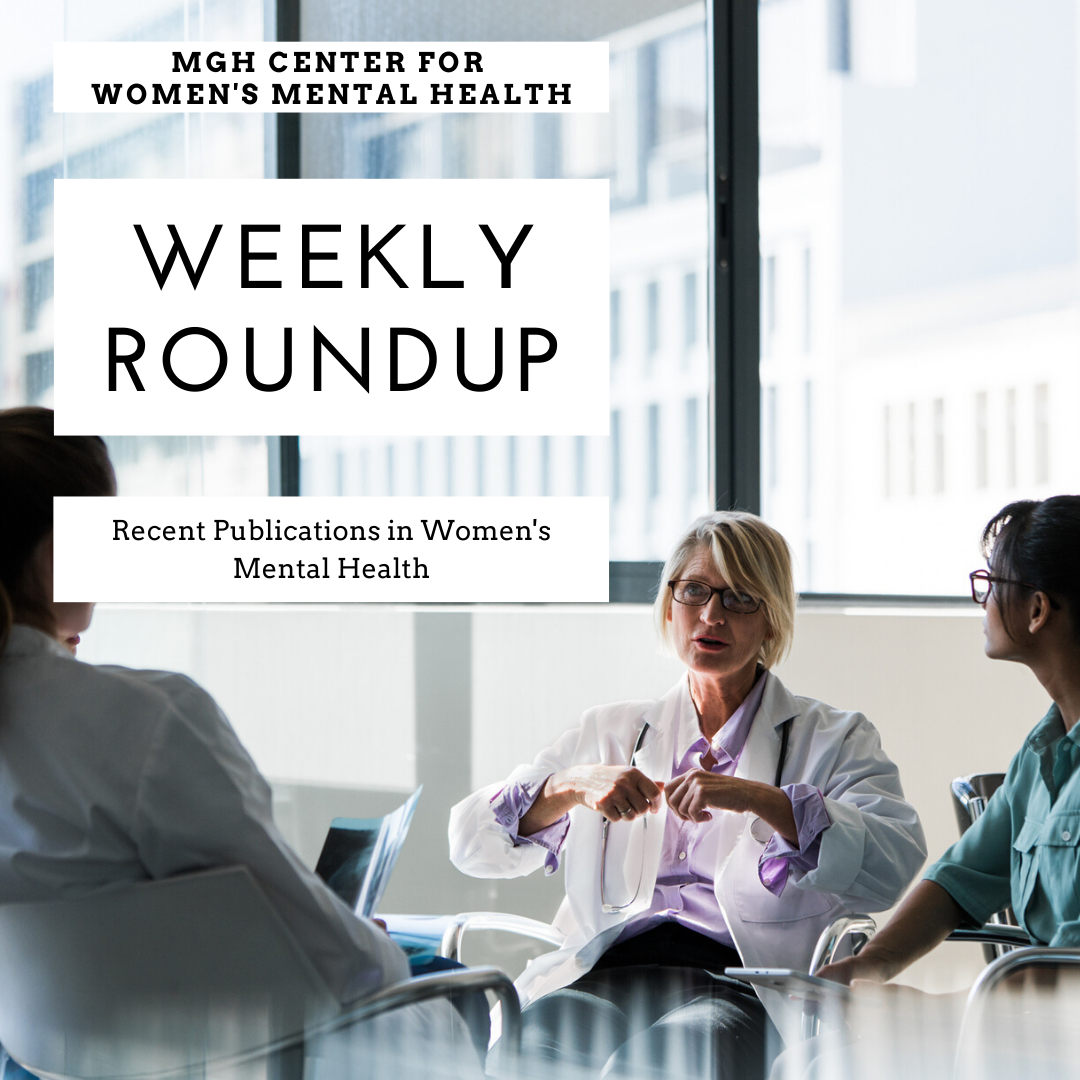Every week we review the most recent publications in women’s mental health, covering topics related to premenstrual symptoms, perinatal mood and anxiety disorders, use of medications in pregnant and breastfeeding women, perinatal substance use, and menopausal mental health.
Just a reminder that registration is open for our fall course on Psychiatric Disorders in Women: Diagnostic and Treatment Considerations Across the Female Lifespan. You can register here with MGH CME. This year the course will be virtual. While this is a disappointment, we hope that it is an opportunity for those who have not been able to make it to Boston during previous years.
For more detailed descriptions of many of these topics, you can sign up to receive our weekly CWMH NEWSLETTER which comes out every Thursday.
Ruta Nonacs, MD PhD
PMS AND PMDD |
| No articles this week
|
INFERTILITY AND MENTAL HEALTH |
| No articles this week
|
PSYCHIATRIC ILLNESS DURING PREGNANCY |
| Factors associated with re-initiation of antidepressant treatment following discontinuation during pregnancy: a register-based cohort study.
Wikman A, Skalkidou A, Wikström AK, Lampa E, Kramer MS, Yong EL, Skoglund C, Epperson N, Sundström-Poromaa I. Arch Womens Ment Health. 2020 Jul 6. Most women discontinued antidepressant treatment during pregnancy (n = 29,095, 75.4%), of whom nearly 12% (n = 3434, 11.8%) re-initiated treatment during pregnancy. The following factors were associated with higher likelihood of restarting antidepressant: high educational level (aOR 1.21, 95% CI 1.08-1.36); prior psychiatric hospitalization (aOR 1.50, 95% CI 1.10-2.03, for three or more episodes); and longer duration of pre-pregnancy antidepressant use (aOR 6.10, 95% CI 5.48-6.77, for >2 years antidepressant use). Aukia L, Paavonen EJ, Jänkälä T, Tolvanen M, Korja R, Karlsson L, Karlsson H, Polo-Kantola P. Sleep Med. 2020 Apr 9;72:150-156. Both depressive and anxiety symptoms in early pregnancy were associated with higher insomnia and sleepiness symptoms in later stages of pregnancy which emphasizes the importance of their assessment in early pregnancy. Polygenic prediction of the risk of perinatal depressive symptoms. Rantalainen V, Binder EB, Lahti-Pulkkinen M, Czamara D, Laivuori H, Villa PM, Girchenko P, Kvist T, Hämäläinen E, Kajantie E, Lahti J, Räikkönen K. Depress Anxiety. 2020 Jul 5. Polygenic risk scores for major depressive disorder, schizophrenia, and cross-disorder in non-perinatal populations generalize to perinatal depressive symptoms. Antipsychotics in Postpartum Psychosis. Teodorescu A, Dima L, Popa MA, Moga MA, Bîgiu NF, Ifteni P. Am J Ther. 2020 Jun 22. The existing studies to date do not allow to draw a definitive conclusion regarding which treatment is the most effective. Existing evidence suggests that antipsychotics alone or in combination are responsible for sustained remission and a more rapid discharge from the hospital. Regional cerebral activity abnormality in pregnant women with antenatal depression. Cheng B, Wang X, et al. J Affect Disord, Sept 2020. Using resting-state fMRI, researchers identified abnormalities in cerebral activity in women with antenatal depression, mainly located within the prefrontal-limbic circuit concerning multiple neural system abnormalities. Fonseca A, et al. J Affect Disord, Sept 2020. Review.
|
MEDICATIONS AND PREGNANCY |
| Trend of antidepressants before, during, and after pregnancy across two decades-A population-based study.
Sun Y, Dreier JW, Liu X, Glejsted Ingstrup K, Maegbaek ML, Munk-Olsen T, Christensen J. Brain Behav. 2019 Nov;9(11). Free Text. Prescription of ADs during pregnancy in Denmark increased steadily from 1997 to 2011 but decreased sharply thereafter. Karanam A, Pennell PB, French JA, Harden CL, Allien S, Lau C, Barnard S, Callisto SP, Birnbaum AK. Ann Neurol. 2018 Oct;84(4):556-563. Gestational week was a better predictor of changes in LTG concentration than estradiol concentration and may reflect additional factors, although neither was robust enough to use clinically due to substantial interpatient variability. Andrade C. J Clin Psychiatry. 2020 Jun 2;81(3):20f13472. Free Article Findings from a meta-analysis of 6 cohort and 2 case-control studies, read along with the results of subsequently published cohort (n = 3) and case-control (n = 1) studies, suggest that a signal does exist to associate early gestational exposure to ondansetron with an increased risk of heart defects and orofacial defects. Nevertheless, even if ondansetron is causally implicated in MCM risk, the absolute increase in risk, such as for orofacial clefts (by 0.03%) and ventricular septal defect (by 0.3%), is small.
|
POSTPARTUM PSYCHIATRIC ILLNESS |
| Suicide Attempts Among Pregnant and Postpartum Women in Japan: A Nationwide Retrospective Cohort Study.
Shigemi D, Ishimaru M, Matsui H, Fushimi K, Yasunaga H. J Clin Psychiatry. 2020 May 5;81(3):19m12993. Postpartum women were more likely than pregnant women to attempt suicide and wer more likely to use lethat means. Oxytocin and postpartum depression: A systematic review. Thul TA, Corwin EJ, Carlson NS, et al. Psychoneuroendocrinology,July 2020. This review was not able to draw any conclusions regarding the relationship between intravenous synthetic oxytocin and postpartum depression based on current evidence due to the heterogeneity and small number of studies (n?=?4). Lønfeldt NN, et al. J Affect Disord, Sept 2020. This nationwide population study did not support an association between oxytocin-stimulated labor and emotional disorders in children up to age 17 years. Ye Z, Whang L, Yang T, et al. J of Maternal-Fetal & Neonatal Medicine, June 2020. Overall, mothers who gave birth to a female infant experienced a significantly increased risk of developing PPD compared with the reference group (OR = 1.15, 95%CI: 1.01–1.31; p?=?.03). Postpartum Depressive Symptoms and Screening Opportunities at Health Care Encounters. Haight SC, Ko JY, Yogman MW, Farr SL. J Womens Health (Larchmt). 2020 Jul 6. A large percentage of women with postpartum depressive symptoms attend well-child visits or receive home visitation, representing opportunities for depression screening and referral for care.
|
MEDICATIONS AND BREASTFEEDING |
| No articles this week
|
PERINATAL SUBSTANCE USE |
| No articles this week
|
MATERNAL MENTAL HEALTH AND CHILD OUTCOMES |
| Does suicidal ideation and depressive mood of parents affect their adolescent children’s mental health?
Lee SK, et al. J Affect Disord, Sept 2020. Adolescent daughters with depressed mothers were 2.52 times more likely to experience depression and 1.51 times more likely to report suicidal ideation. Sons’ depressive mood was rarely affected by the psychological status of mothers or fathers.
|
MENOPAUSE AND MENTAL HEALTH |
| Ozdemir K, et al. Depression, anxiety, and fear of death in postmenopausal women. Menopause 2020.
Amongpostmenopausal women seen in a GYN clinic, 41% presented with depressive symptoms.
|
OTHER TOPICS IN WOMEN’S MENTAL HEALTH |
| No articles this week |




Wow, Great information and this is very useful for us.